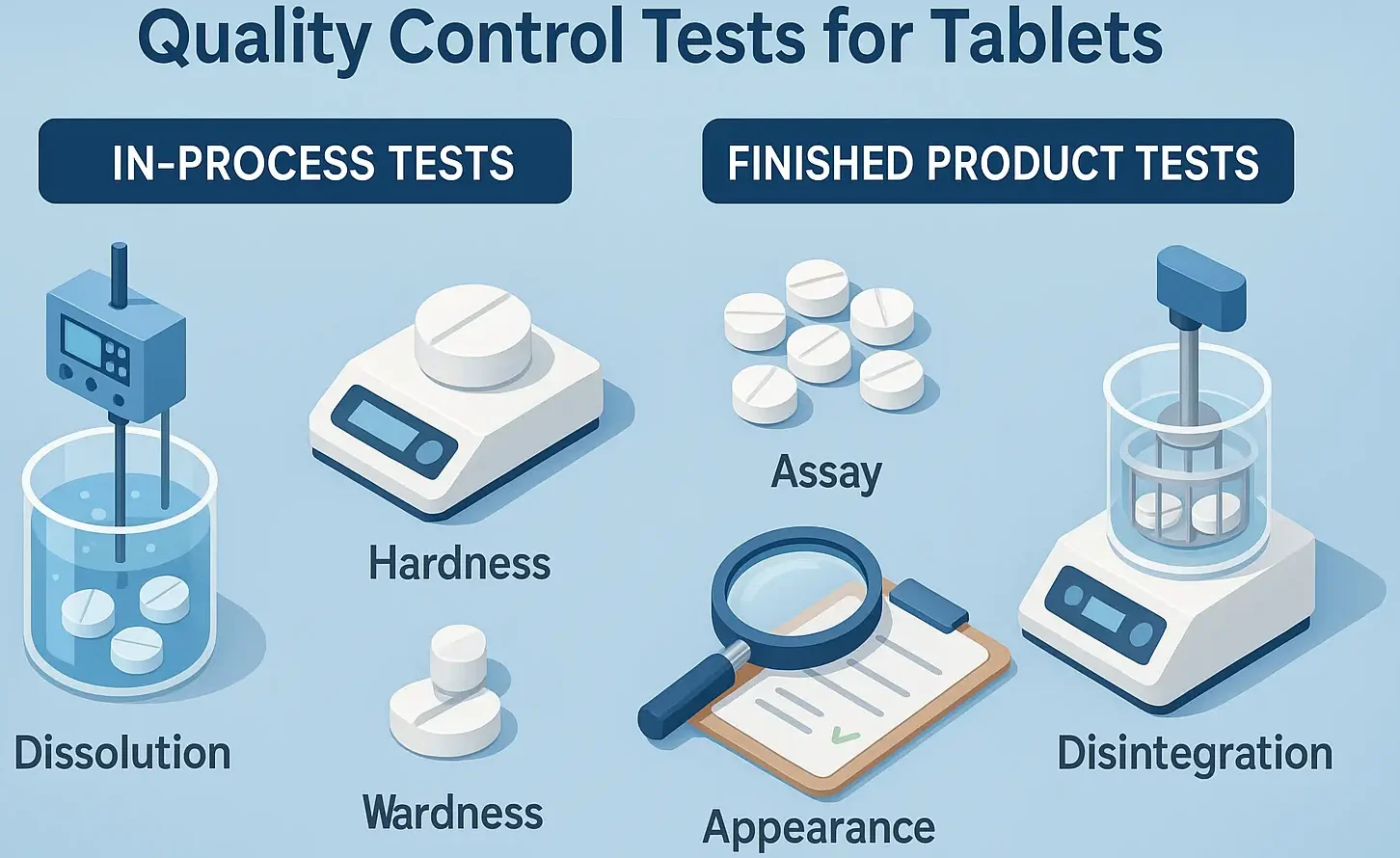Ensuring the quality and consistency of tablets and their coatings is critical. Quality control involves both in-process and finished product tests.
In-Process Tests
- These tests are conducted during manufacturing to monitor and control the process parameters.
-
Powder Flowability
- Purpose: Ensure that the powder blends flow smoothly through the manufacturing equipment.
-
Methods:
- Angle of Repose: Measures the slope formed by poured powder.
- Flow Through an Orifice: Measures the rate at which powder flows through a standardized opening.
- Hausner Ratio: Compares tapped and bulk densities.
-
Granule Size Distribution
- Purpose: Ensure uniform granule size for consistent tablet compression.
-
Methods:
- Sieving: Passing granules through a series of sieves.
- Laser Diffraction: Analyzing particle size based on light scattering.
-
Moisture Content
- Purpose: Prevent issues like stickiness, microbial growth, or degradation.
-
Methods:
- Karl Fischer Titration: Quantitative determination of water content.
- Loss on Drying (LOD): Heating the sample and measuring weight loss.
-
Tablet Hardness Testing
- Purpose: Ensure mechanical strength for handling and packaging.
-
Methods:
- Compression Testing: Using a hardness tester to apply force until the tablet breaks.
-
In-Process Uniformity
- Purpose: Monitor uniform distribution of API and excipients.
-
Methods:
- Sampling: Regularly taking samples from batches for testing.
Finished Product Tests
- These tests are conducted on the final tablet product to ensure it meets all quality specifications.
Advertisements
Weight Variation
- Purpose: Ensure each tablet contains a consistent amount of content.
-
Methods:
-
- Individual Weighing: Weighing a sample of tablets individually.
- Statistical Analysis: Comparing mean and standard deviation against specifications.
Content Uniformity
- Purpose: Ensure each tablet contains the exact amount of API.
-
Methods:
- Spectroscopy: Using UV-Vis or IR spectroscopy to quantify API.
- High-Performance Liquid Chromatography (HPLC): Precise measurement of API concentration.
Dissolution Testing
- Purpose: Ensure the tablet releases the API at the desired rate.
-
Methods:
- USP Apparatus: Using standardized dissolution apparatus (e.g., paddle, basket).
- Spectrophotometric Analysis: Measuring API concentration in the dissolution medium over time.
Disintegration Testing
- Purpose: Assess the tablet’s ability to break down in the GI tract.
-
Methods:
- USP Disintegration Tester: Placing tablets in a controlled medium and observing disintegration time.
Hardness and Friability
- Hardness: Re-measured to confirm tablet strength.
- Friability: Assesses the tablet’s resistance to mechanical stress.
-
Methods:
- Using a friabilator to rotate tablets and measure weight loss.
Advertisements
Coating Integrity
- Purpose: Ensure the coating is uniform and defect-free.
-
Methods:
- Visual Inspection: Checking for visible defects.
- Microscopy: Analyzing coating thickness and uniformity.
- Solvent Extraction: Quantifying coating material.
Stability Testing
- Purpose: Assess the tablet’s shelf life under various environmental conditions.
-
Methods:
- Accelerated Stability Testing: Storing tablets at elevated temperature and humidity.
- Real-Time Stability Testing: Monitoring tablets over extended periods under normal conditions.
Taste and Odor Assessment
- Purpose: Ensure palatability, especially for chewable or ODTs.
-
Methods:
- Sensory Evaluation: Trained panels assess taste and smell.
Advertisements
Uniformity of Coating
- Purpose: Verify consistent coating thickness and appearance across all tablets.
-
Methods:
- Thickness Measurement: Using micrometers or non-destructive techniques like near-infrared (NIR) spectroscopy.
- Colorimetric Analysis: Ensuring consistent color intensity and hue.

